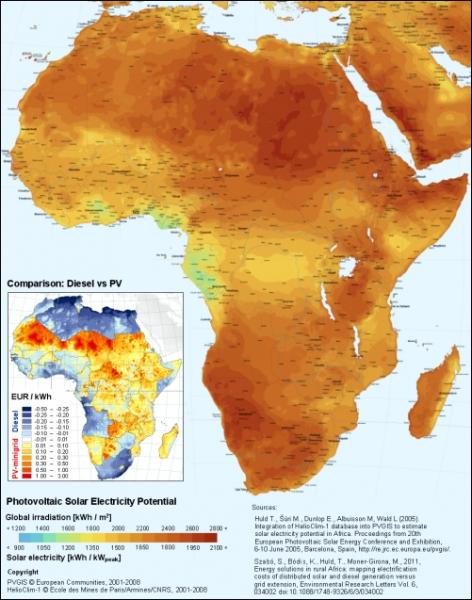Per capita electricity consumption in Africa is well below the average for residents of the European Union but that doesn’t mean that the continent is short of sustainable power-generating potential, according to a report published by the European Commission’s Joint Research Centre.
Exact statistics on power and renewable energy in Africa are hard to come by, but EC experts at JRC calculate that the continent’s electricity consumption is massively behind that of Europe with much of the rural population without access to electricity at all, severely hampering development.

Yet the power of the sun, wind and even the continent’s rivers could be the key to unlocking Africa’s sustainable power potential especially in the remotest regions.
“We have tried to evaluate the potential of renewable energy in Africa and we have seen that that potential exists,” said one of the report’s editors, Fabio Monforti-Ferrario. “The idea is for Africa, especially the Sub-Saharan area, to shape energy systems by including renewable energy from the very beginning – from the design phase.”
The report, ‘Renewable Energies in Africa: Current Knowledge’ published in February (and available here in the capacity4dev.eu Public Group on Energy), aims to help African governments develop their renewable energy plans and found that rural communities could benefit most from renewable energy.
Countless villages across sub-Saharan Africa are not linked to any power grid network and bringing this type of infrastructure to such remote locations is extremely costly. Low population density regions of less than 50 people per square kilometre would never be cost competitive according to the report, making the exploitation of local renewable energy resources particularly attractive.
The industrialised nations of Europe and North America are struggling amid fears over climate change and rising oil prices to draw more of their energy needs from renewable sources. But Africa could by-pass this stage of investment in heavy infrastructure and benefit from cheaper, localised and renewable energy sources.
“It would be interesting to see if sub-Saharan African countries could solve the problem of using renewable energy from a different perspective by incorporating renewables from the beginning in their energy planning,” Mr Monforti-Ferrario added.

Off-grid solar wind and biomass projects could meet communities’ needs by generating smaller amounts of electricity closer to the end consumer. For example, fitting schools with solar panels and using small scale wind turbines to supply villages.
But Mr Monforti-Ferrario did offer a word of caution, especially in the use of biomass. Biomass, which includes cattle dung, wood and charcoal, and is already the most widely used energy source in sub-Saharan Africa but in the most part it is not used in a sustainable nor safe manner.
Up to 80% of energy is lost in the production of charcoal and many biomass fuels can be harmful if their smoke is inhaled from poorly designed cooking stoves or open fires. Commission experts are familiar with this challenge as the EU has been supporting energy efficiency and household energy strategies, for example in the Sahel region.
Without access to energy, economic development remains largely out of reach. Last year, UN Secretary General Ban-Ki Moon launched the ‘Sustainable Energy for All’ Initiative, which is supported by the European Commission.
JRC is the European Commission’s in-house science service. Its mission is to provide customer-driven scientific and technical support for the conception, development, implementation and monitoring of European Union policies.
For further reading, please visit the Public Group on Energy on capacity4dev.eu
|
Since 2002, the EU Energy Initiative for Poverty Eradication and Sustainable Development (EUEI) has used various instruments addressing infrastructure and policy needs to support access to sustainable energy in African countries. Through the ACP-EU Energy Facility Programme, the EC focuses on increasing access to energy to rural areas with the potential to reach twelve million beneficiaries. |
This collaborative piece was drafted with input from Fabio Monforti-Ferrario and Alessandro Bianciardi with support from the capacity4dev.eu Coordination Team.
FURTHER INFORMATION
There is further reading on the www.ecology.com website.
Please see related content on the Africa-EU Partnership website:
http://www.africa-eu-partnership.org/articles/screening-africas-renewab…
http://www.africa-eu-partnership.org/fr/node/2706
A video, in Italian, from the Varese Natura spot on the R55 web channel features interviews with JRC staff.

Please click here to watch it.

Log in with your EU Login account to post or comment on the platform.